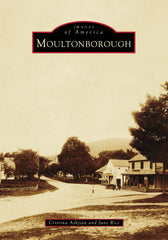Publishing Today!
Check out the newest local history books publishing today!
The History Press
St Louis Trailblazer Erma Bergmann by Patricia Treacy

Erma Mary Bergmann was a generation ahead of her time. She was born in a cold-water flat over a shoe store on South Broadway in St. Louis's Soulard area. Restrained by the Great Depression and the minority status of women in the 1930s and '40s, she hoped someday to climb out of poverty. When she was recruited to play baseball with the All-American Girls Professional Baseball League, her life changed. She pitched a no-hitter in 1947. She parlayed her natural athletic ability into two successful careers, baseball and policing. She spent twenty-five years as a policewoman, serving on the dangerous Decoy Squad. Author Patricia Treacy details the history of a pioneering woman.
Classic Restaurants of Michiana by Jane Simon Ammeson

Once a stagecoach stop, The Old Tavern Inn has been open since the time of President Andrew Jackson. Tosi's is known for its gorgeous starlit garden and gastronomic traditions stretching back almost a century, and The Volcano was amongst the first pizzerias in the country. These restaurants and other classic eateries remain part of the thriving local food scene. But the doors of others have long been closed. Some like Mead's Chicken Nook and Robertson's Tea Room linger in memories while The Owl Saloon, O. A. Clark's Lunch Rooms, and Lobster Lounge are long lost to time.
Arcadia Publishing
Flight Training at the United States Naval Academy by Andre J. Swygert

The United States Naval Academy was founded in 1845 in Annapolis, Maryland, after experience showed that the policy of training naval officers solely through shipboard experience was ineffective. The development of aircraft in the early 20th century was a technological change that impacted the academy. The efforts of naval aviation advocates, led by Capt. Washington I. Chambers, resulted in the Navy acquiring its first aircraft in 1911 and basing them near the US Naval Academy where sufficient land and material resources were available to support flight operations. Later, under Supt. Adm. Louis W. Nulton, aviation entered the curriculum as an element of fundamental naval education, taking a place among major subjects such as seamanship and gunnery. Classroom instruction and indoctrination flights provided all midshipmen with a familiarization in aviation as an important element in their development as naval officers before circumstances forced a shift of training to other facilities by 1962.
Cardiff by Jim Ridings

The discovery of a rich coal vein in northeast Livingston County, Illinois, in 1899 turned an open prairie into the large coal mining town of Cardiff within months. An explosion in the mine in 1903 that killed nine men looked like it might be the end of the mine and the town, but another mine shaft was sunk, and the town grew bigger than ever. However, the quality of the coal ran out in 1912. This time it was the end. The mine closed, and the buildings were transported elsewhere. The only thing left of Cardiff was its ghost town reputation. The town lasted only 13 years, but they were exciting years. This book brings the town and its people to life once again.
Moultonborough By Jane Rice and Cristina Ashjian

Granted in 1763 and incorporated in 1777, Moultonborough was named in honor of Col. Jonathan Moulton, a legendary figure in state history. The town's historical development is closely tied to its location between lakes and mountains and to transportation routes established during the 19th century. Before the advent of tourism, Moultonborough remained primarily an agricultural economy with local supporting industries. Expanding railway and steamboat lines in the late 19th century brought seasonal tourism along with summer homes, grand country estates, and recreational facilities. Long Island became a significant transportation hub, allowing people and goods to be transported all over Lake Winnipesaukee. By the mid-1830s, Moultonborough Corner, at the intersection of stagecoach routes between area towns and lakeside landings, grew into the municipal center. Moultonborough developed a tourism-based seasonal economy in the 20th century, and it is now best known for such landmark destinations as the Old Country Store and the Castle in the Clouds. It is also home to the annual Lee's Mills Steamboat Meet.
Morven By Elizabeth Allan and Jesse Gordon Simons

Morven stands on five acres in the heart of Princeton, New Jersey, and has played a role in the state's and nation's history for more than 200 years. After Morven was built for Richard Stockton, a signer of the Declaration of Independence, four generations of Stocktons resided there through the early 20th century before the property was leased to Robert Wood Johnson, chairman of Johnson & Johnson. He was followed by five New Jersey governors when Morven served as the state's first governor's mansion. Morven has hosted presidents from George Washington to John F. Kennedy and other notable people, including foreign leader Fidel Castro, movie star Grace Kelly, astronaut Buzz Aldrin, and star athlete Althea Gibson. Morven opened as a museum and garden in 2004. The mansion building that serves as the museum is the largest structure on the property, but other notable landmarks include the 1930s pool house, 19th-century carriage house, and colonial revival garden. Morven depicts over 225 years of history and includes views of a home and property that survived wars, fires, and changing tastes.
Newark Museum of Art by William A. Peniston

As the largest museum in New Jersey, the Newark Museum of Art has assembled important and highly regarded collections in the fine arts and decorative arts. It has collected specimens of rocks and minerals as well as plants and animals to illustrate the natural sciences. In all of these areas, it has developed innovative exhibitions. Finally, it has designed engaging educational programs that are both inspirational and transformative for people of all ages from the diverse communities that it serves. In many respects, it remains the model of the "new museum" that was imagined at its inception--a place dedicated to objects and the ideas embodied by them. In the words of founding director John Cotton Dana, "A good museum attracts, entertains, arouses curiosity, leads to questioning, and thus promotes learning."
If you didn't see anything from your town in this list, feel free to check out local history books about your town at www.arcadiapublishing.com

